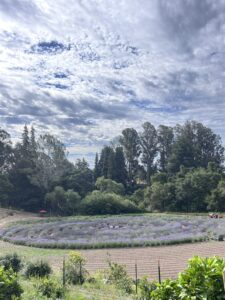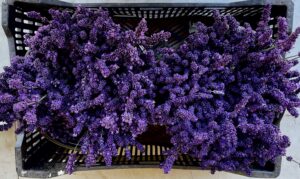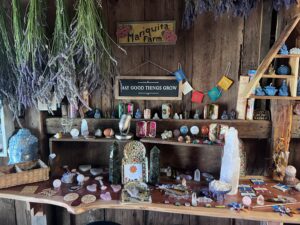Waiting For The World To Come To Me

The Ladybug’s Lavender Labyrinth is coming into full bloom now. There are several varieties of lavender presently flowering, including “Ellagance,” “Hidcote” and “Provencal.”
You don’t get into row crop farming for world travel, that’s for sure! Maybe, if you work for one of the big boys in Salinas, like Taylor Farms, Dole, or T&A, you may travel to Irapuato, in Mexico, or to Chile’s Central Valley to check in on the winter production. If you’re a fresh produce sales manager for a big corporation you might go anywhere on the planet as your company seeks to increase global brand and gain market share. But if you’re an actual dirt farmer, like me, and you drive the tractor, move the irrigation, hoe the weeds, and plant and pick the crops, it can be difficult to get very far from land that sustains you.

Our friend and neighbor/farmer, Bethany, of Prickly Poppy Farm, took this bird’s eye view of the labyrinth with her drone.
I live on a gorgeous piece of rural property, and I don’t regret that a life in farming has usually seen me parked on some remote scrap of ground. They’ve always been gorgeous scraps of earth anyway, like the Gothic Victorian I lived in on the dairy in Marshal with a view of Hog Island on the Tomales Bay and the Pt. Reyes Peninsula in the background, or the trailer on the cattle ranch in Siskiyou County with its majestic, close-up encounter with Mt. Shasta, or the sight of the sun rising in the east at dawn over Mt. Tamalpais from the cabin window on the vegetable farm in Bolinas…Stuck in Paradise, lol… Sometimes I’ll joke with my friends who have traveled the world that “I’ve let the world come to me.” If you consider the folks who have visited the farm when we’ve offered U-Pick events, I ‘m only speaking to the facts.
One nice thing about having visitors drop in from far away places is that they help me see my own place with new eyes, and that’s as good an experience as traveling can give you. Starr and I work on the farm about 6.78 days of the week and when we go out our door into the yard and look around, it’s hard not to focus on the work that HASN’T gotten done. But our U-Pick visitors arrive at the farm and they see what we have done, and their enthusiasm is refreshing. We’re presently holding a series of U-Pick lavender events, and meeting these visiting U-Pickers has reminded me of the people I’ve met in the past and the distant places I’ve never visited.
First, there were the Russians. When we were doing a lot of farming over in the Hollister/Gilroy area we would often hold Tomato U-Picks. I learned that Eastern Europeans take their tomatoes VERY seriously. On the morning of our first tomato U-Pick three vans pulled up, each driven by a Russian mother with her own kids in back, plus a neighbor’s child or two in tow. They were participating in a community tomato canning project, with some women harvesting in the field and others processing the tomatoes back in the kitchen. The harvesting mothers knew exactly what to do, because they’d grown up on farms in Russia. The mothers assembled the kids, handed out the boxes, showed the children how to properly pick tomatoes, and told them to get scampering. As each kid came out of the field their tomatoes were inspected, weighed, and boxed up until, collectively, before the sun had even climbed high in the sky, the three vans of mothers and children had picked over a thousand pounds of perfect, ripe fruit. As they worked, the women chatted in Russian, and while I couldn’t understand a word they said, it was hard not to notice how much they enjoyed being back out in the open countryside once again, with the smell of fresh, ripe tomatoes in the air, but this time THEY were in charge of the harvest, no longer just being the girls getting bossed around. That crew came back every year and, often, on the first warm day in spring, we’d get an email from the head mother, asking as to when the tomatoes would be ripe? If they hadn’t already had careers and situations going for them where they were living on the Peninsula, I’d say these women could easily get into the harvest management business in the Salinas Valley because they had the skills to effectively assemble and motivate a picking crew.

Ellagance is one of the shorter stemmed lavenders, but also one of the brightest, and it is very fragrant.
I’ve never been to India, either. I’ve learned that while many of the East Indians who live in the South Bay and Silicon Valley may have attended the most prestigious universities in India, or abroad, many of them actually started their lives in village India, far from the virtual, logical, international and transformative platforms they live on now. While they may have come to the farm to pick eggplant, basil, or squash, I noticed that many of them brought their kids with them; kids who did not necessarily want to be there.

Can you see the turkeys roosting in the Torrey Pine’s branches as the solstice moon rises? I count at least 5 in this photo, but there were over a dozen turkeys in the yard a minute ago.
“It’s too hot,” I remember one pre-teen telling his mother. The mother and her friend had a big laugh over that.
“No,” they said. “It was hot in the village when it was 43 degrees (Celsius) and there was no air conditioning. This is cool. Pick your grandmother some eggplants.,”
But, as “hot” and “boring” as things could be on the farm, I noticed it was never too long before something interesting and different happened to divert the kids. One year a fire broke out on an adjoining ranch and the Fire Retardant Bombers flew overhead. Another year there was the appearance of a Gopher Snake, three and a half feet long, with all the attendant drama. And there was that time that the sheriff raided an illegal cannabis grow on a next door ranch and there were helicopters and SWAT teams.

Isn’t it amazing how there’s a turkey that is as handsome as me?

Besides “U-Pick” lavender, we will have our freshly dug potatoes for sale.
One year a visitor really surprised me. He was from India and he worked in high tech. He met me in the farmers market and told me that he had a dream of “going back to the land.” I’ve heard that before. This fellow came to several U-picks and asked lots of questions about insect management, water management, weed management, labor management, marketing, and community engagement. He continued to visit me at the market and ask questions about specific crops, about Community Supported Agriculture, about coolers, about fertilizers. The last time I saw him he told me that he had inherited his grandfather’s rural property in India, and that he was leaving high tech and really going back to his family’s roots. He said that he’d observed the curiosity and interest that my Indian visitors had taken in our farm in California, and he was creating a little farm in India that could reach out to urban dwellers who were losing touch with their rural past and engage their interest and hope to help preserve India’s small farm economy. He thanked me for the inspiration. That was a nice thing to hear.
Because I’ve worked with many Oaxacans over the years, word got out that I grow chilacayote, a huge, hard squash which is especially esteemed in Oaxaca and points south through Central America. You can sometimes buy chilacayote in Watsonville in the Hispanic markets but the supply and quality is not reliable. I got a call one day from a woman who wanted to come out to the farm and pick her own chilacayote. She showed up with a nephew to help her carry the heavy chilacayote up the hill.
“This one is REALLY hard,” she explained to me, “Muy macizo!”
“Macizo” was good. She wanted that one; the ones in the tiendita were always too “tiernito,” too young, tender, and undeveloped.” Her squash turned out to be 30#. By the time she was done her nephew had dragged 200# of chilacayotes up the hill. When she came back a year later she brought her daughter and her two grand-children. She loved the farm scene with the corn, squash, beans, flowers, and donkeys because it reminded her of the farm she’d grown up on in Oaxaca. The grandchildren, a boy, aged 10, and a girl, aged 7, were preparing to be bored, especially the 10 year old. We were walking to the chilacayote patch when a wild turkey exploded out of the willow brush in front of us and fled, flapping up a big drama and incoherently squawking in terror.
“Look!” said the sister. “A peacock!”
“You’re stupid,” her big brother told her. “That’s a turkey.”

Besides lavender, we grow a wide range of citrus, flowers, herbs, and vegetables. These are Buddha’s Hand Citrons, bound for Gather Flora LA in the Los Angeles Flower Market.
The granddaughter scowled. She wasn’t happy, but she wasn’t stupid. In Mexican Spanish the word for “turkey” is “guajolote,” from the Nahaul word “huehxolotl.” But, in the Castilian Spanish taught in schools, a “turkey” is a “Pavo.” And, in “proper” Spanish, a peacock is a “Pavo Real,” or “Royal Turkey.” The granddaughter kept scowling, but she was thinking hard.
“I’m going to call it a “MEXICAN PEACOCK!” she declared. Defiant! to the end.
We all had to laugh. …And agree.
Wild Turkeys may look black or brown from a distance, and they camouflage themselves so perfectly that you often don’t even see them from a distance. But, up close, wild turkeys shimmer. They’re iridescent, psychedelic, and weird as hell. When you look in their eyes you can see that they’re broadcasting and receiving on an entirely different channel. Their heads turn colors, they puff up theatrically, they won’t shut up with all the gobbling, and yet they survive. The Mountain lions, bobcats, coyotes, foxes, hawks and owls all eat their babies like popcorn, but yet they persist. Turkeys look like flying dinosaurs. They are easily as trippy a creature as any Peacock ever was. They are always here “U-Picking” and I can’t see them without thinking about the “Mexican Peacock.”

I’m holding a fruit cluster of Cuban Shaddock. If you have a dining room table the size of an airstrip this would work as a centerpiece. I love this plant for its flowers, its scent, and its drama. It also has thorns that could pop a truck tire.

A visiting couple with a modest haul of lavender. They are going to have a fragrant drive back to San Francisco.

Starr’s Farm Store is full of the dried herbs, lavender products and preserves from the farm, plus her collection of other treasures from the earth.
We want this property to be a beautiful, productive garden that is as abundantly full of life as is possible, so I don’t want to bow to tradition and shoot the turkeys, but these “Mexican Peacocks” are annoying. And they’re no more a native than I am, or even less so….The wild Turkeys we have here are descended from wild turkeys that the California Department of Fish And Game brought in from Arizona in the ’50s in an effort to increase sales of hunting licenses, and my family has been here since 1892 when my Danish Great Grandfather dodged the German Army Draft in occupied Schleswig and immigrated to Watsonville. Different times! Now the turkeys run riot. I like that they eat a lot of insects, like ticks, but I’m not thrilled that they peck at my crops. The worst is when they choose to make a dust bath in my planted beds and roll around like Rhinos until their itch is scratched and my sowing is ruined.” And the males are known to fight their reflections in the glass door to Starr’s farm store and make a mess on the porch.
So the turkeys are tolerated, but you are welcome to visit and pick your own lavender. The splendid lavender labyrinth is worth the trip in itself, and we will have farm produced citrus, potatoes, herbs, and flowers available for sale as well. We have several nice picnic spots for people that want to relax for a while with the birds and the bees. Bee sure to check our website @mariquita.com and register to visit soon. We will be hosting Lavender U-Picks through July 26th. We hope to see you. Thanks, Andy & Starr
.
|



